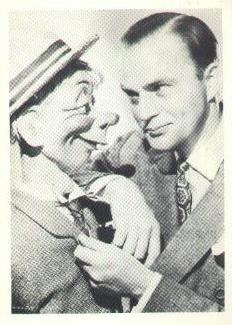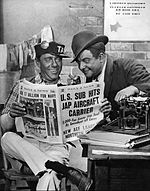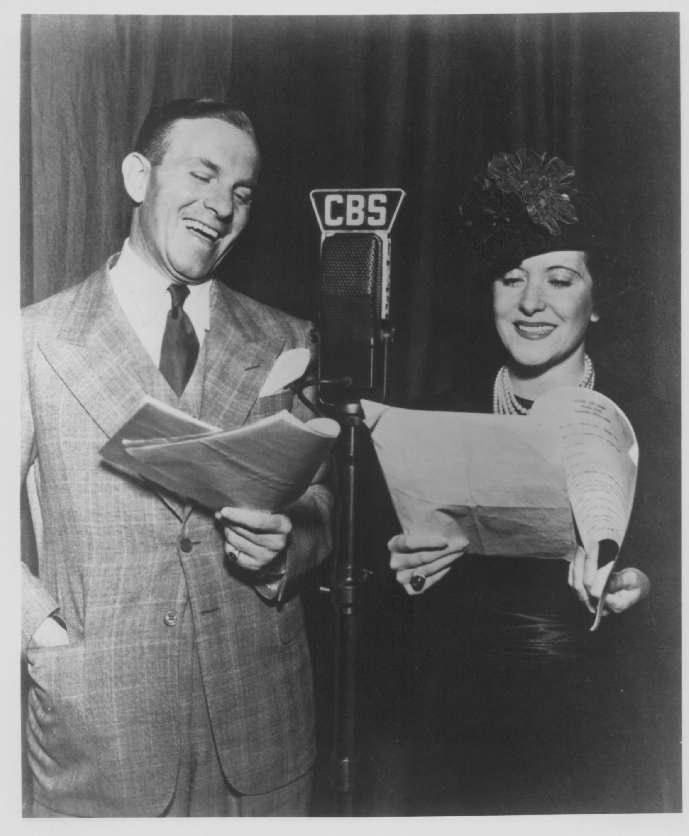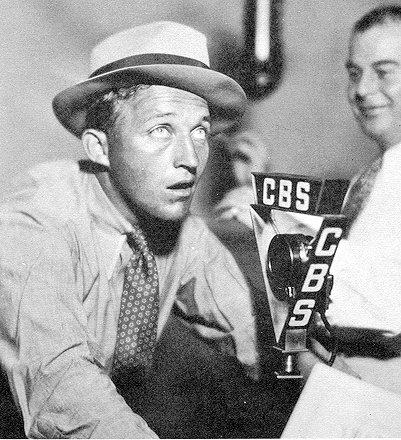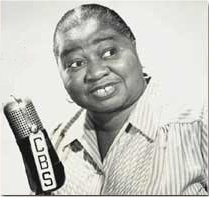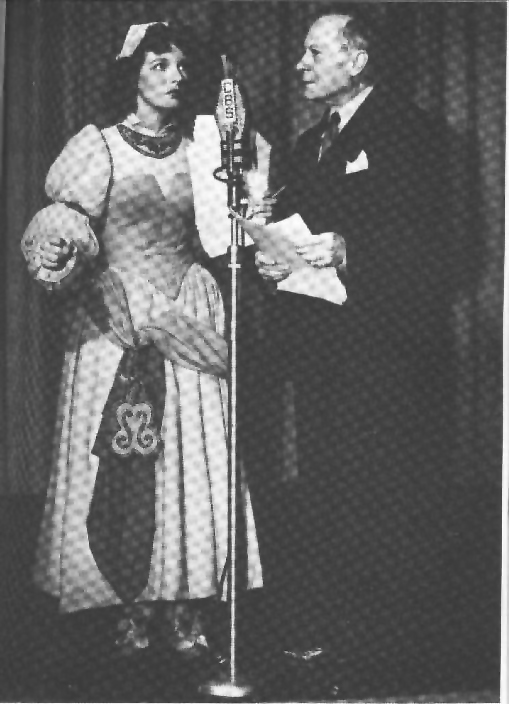|
The Chase and Sanborn Hour was the umbrella title for a series of US comedy and variety radio shows, sponsored by Standard Brands' Chase and Sanborn Coffee, usually airing Sundays on NBC from 8pm to 9pm during the years 1929 to 1948.
The series began in 1929 as The Chase and Sanborn Choral Orchestra, a half-hour musical variety show heard Sundays at 8:30pm on NBC. When Maurice Chevalier became the show's star, he received a record-breaking salary of $5000 a week. Violinist David Rubinoff (September 13, 1897 – October 06, 1986), became a regular in January 1931, introduced as "Rubinoff and His Violin."
With Chevalier returning to Paris, Eddie Cantor was chosen as his replacement and the new 60-minute program, The Chase and Sanborn Hour, was launched September 13, 1931, teaming Cantor with Rubinoff and announcer Jimmy Wallington. The show established Cantor as a leading comedian, and his scriptwriter, David Freedman, as “the Captain of Comedy.” When Jimmy Durante stepped in as a substitute for Cantor, making his first appearance on September 10, 1933, he was so successful that he was offered his own show. Then the world's highest paid radio star, Cantor continued as The Chase and Sanborn Hour's headliner until November 25, 1934.
With a new format, The Opera Guild, hosted by Deems Taylor, began December 2, 1934, Sundays at 8pm, on The Chase and Sanborn Hour, and that concert series continued until March 17, 1935. Major Bowes' Amateur Hour had the slot from March 24, 1935 until September 11, 1936, followed by Do You Want to Be an Actor?, with Haven MacQuarrie, broadcast from January 3, 1937 until May 2, 1937, a series that continued Sundays at 10:30pm as a half-hour show from December 5, 1937 until February 20, 1938.
Meanwhile, Chase and Sanborn found a gold mine with a wooden dummy when Edgar Bergen and Charlie McCarthy began an 11-year run, starting May 9, 1937. Initially this incarnation of the program also featured as regulars master of ceremonies Don Ameche, singers Dorothy Lamour and Nelson Eddy, and (for the first few weeks) comedian W.C. Fields, accompanied by a different guest star each week. Perhaps the most infamous of the latter was Mae West, whose appearance on the program of December 12, 1937 was highlighted with a sexually suggestive "Adam and Eve" sketch that caused a public outcry and resulted in West being banned from the radio airwaves for many years thereafter.
Beginning January 7, 1940, the regular cast apart from Bergen and McCarthy were dropped and the show was cut to a half-hour and retitled The Chase and Sanborn Program. Also beginning in 1940, the program would go on hiatus for a number of weeks each summer. CBS would fill its airtime with a different substitute show each year; these included The Bishop and the Gargoyle (1940), What's My Line? (1941), Star-Spangled Vaudeville (1942), Paul Whiteman Presents (1943), The Gracie Fields Show (1944), The Frances Langford Show [aka The Chase and Sanborn Program] (1945), and Alec Templeton Time (1946-47). In the fall of 1948 Chase and Sanborn announced that it would terminate its contract with Edgar Bergen at the end of the year. The remaining Bergen/McCarthy programs eschewed guest stars in favor of regular sketches featuring Don Ameche and Marsha Hunt as The Bickersons. In 1949 Bergen went to CBS, with a new weekly program (The Charlie McCarthy Show) sponsored by Coca-Cola. |
| |
|
Amos 'n' Andy creators Gosden and Correll were white actors familiar with minstrel traditions. They met in Durham, North in 1920. Both men had some scattered experience in radio, but it was not until 1925 that the two appeared on Chicago's WQJ. Their appearances soon led to a regular schedule on another Chicago radio station, WEBH, where their only compensation was a free meal. The pair's hopes were that the radio exposure would lead to stage work; they were able to sell some of their works to local bandleader Paul Ash which brought them enough name recognition to be offered jobs at the Chicago Tribune's station WGN in 1925. The offer was steady and lucrative enough to allow them to now become full-time broadcasters. The Victor Talking Machine Company was also interested enough to offer them a recording contract.
Since the Tribune syndicated Sidney Smith's popular comic strip The Gumps, which had successfully introduced the concept of daily continuity, WGN executive Ben McCanna thought a serialized version would work on radio. He suggested that Gosden and Correll adapt The Gumps for radio. The idea seemed to involve more risk than either Gosden or Correll was willing to take; neither was adept at imitating female voices, which would have been necessary for The Gumps. They were also conscious of having made names for themselves with their previous act. By playing the roles of characters doing dialect, they would be able to conceal their identities enough to be able to return to their old pattern of entertaining if the radio show was a failure.
Instead, they proposed a series about "a couple of colored characters" but borrowing certain elements of The Gumps. Their new show, called Sam n' Henry began on January 12, 1926, and fascinated radio listeners throughout the Midwest. It became so popular that in 1927 Gosden and Correll requested it be distributed to other stations on phonograph records in a "chainless chain" concept that would have been the first radio syndication. When WGN rejected the proposal, Gosden and Correll quit the show and the station (their last musical program for WGN was announced in the Chicago Daily Tribune of January 29, 1928). Episodes of Sam 'n' Henry continued to be aired until July 14, 1928. Contractually, Correll and Gosden's characters belonged to WGN, so when they left WGN, they performed in personal appearances but could not use the character names from the radio show.
WMAQ, the Chicago Daily News station, hired Gosden and Correll and their former WGN announcer, Bill Hay, to create a series similar to Sam 'n' Henry. They offered higher salaries than WGN and the right to pursue the "chainless chain" syndication idea. The creators later said they named the characters Amos and Andy after hearing two elderly African-Americans greet each other by those names in a Chicago elevator. Amos 'n' Andy began on March 19, 1928 on WMAQ, and prior to airing each program they recorded their show on 78 rpm disks at Marsh Laboratories, operated by electrical recording pioneer Orlando R. Marsh. Early 1930s broadcasts of the show were done from the El Mirador Hotel in Palm Springs, California
For the program's entire run as a nightly serial, Gosden and Correll portrayed all the male roles, performing over 170 distinct voice characterizations in the show's first decade. With the episodic drama and suspense heightened by cliffhanger endings, Amos 'n' Andy reached an ever-expanding radio audience. It was the first radio program to be distributed by syndication in the United States, and by the end of the syndicated run in August 1929, at least 70 stations besides WMAQ carried the program by means of recordings. |
|
|
Real life husband and wife team, George Burns and Gracie Allen, star in this radio sitcom which ran from June, 1945- February of 1950. Most of the antics revolve around Gracie's dizzy behaviors and George's responses. This show includes some of the typical one-liners and gimmicks of George Burns and Gracie Allen's vaudeville acts. In order to follow the variety show format, rather than just comedy acts by the stars, music and singers were featured between segments performed by Burns and Allen. From 1946-1949 the show was titled, Maxwell House Coffee Time, after the show's sponsor, Maxwell Coffee- "Good to the last drop,"
|
|
|
The Kraft Music Hall was a popular variety program, featuring top show business entertainers, which aired on NBC radio and television from 1933 to 1971.
The Kraft Program debuted June 26, 1933 as a musical-variety program featuring orchestra leader Paul Whiteman and served to supplement print advertising and in-store displays promoting Kraft products. During its first year the show went through a series of name changes, including Kraft Musical Revue, until it finally settled on Kraft Music Hall in 1934. Paul Whiteman remained the host until December 6, 1935. Ford Bond was the announcer.
Billed as "The King of Jazz", Paul Whiteman was arguably America’s first popular music superstar. Whiteman’s foresight regarding the coming of the jazz age and his decisions to hire the best jazz musicians was a powerful boost for jazz, swing and blues. Though he was prohibited from hiring black performers, he hired arrangers and composers.
Bing Crosby took over as master of ceremonies January 2, 1936. Crosby was host until May 9, 1946. For the advertising managers at Kraft, it was imperative that advertising and entertainment be kept separate. For this reason, Kraft insisted that an announcer, not cast members, read its commercials. Additionally, Kraft commercials were single-product focused during the radio days, short and to the point in order to keep with Kraft's philosophy that quality entertainment led listeners up to the commercials, dropped them into the commercials, and took them back to the show, as evidenced by the broadcast of June 15, 1944: When Crosby and Marilyn Maxwell finish singing “Take It Easy,” Bing segues to the ad with, “Check it friends, The Charioteers (the studio chorus) will further demonstrate immediately after my colleague glibly hustles prospective purchasers.” Announcer Ken Carpenter commences a 39-second spot extolling the virtues of Kraft Dinner – “Well, I can tell you of macaroni and cheese that helps you three ways. Saves cooking time, saves shopping time, saves ration points.”
Crosby was the longest-running Kraft Music Hall host, from 1936 through 1946. His casual style and humorous easy-going banter made the show tops with the young "country club" set. The average listener was 21 during this period, compared to the average age of 11 at the movie houses. Intelligent humor and delightful guests made these years some of the greatest. On the show, Bing rubbed elbows with the likes of Spike Jones, Lucille Ball, The Andrews Sisters, Nat “King” Cole and Peggy Lee. It was during these years on the Kraft Music Hall that Bob Burns popularized his famous “bazooka” instrument (made from a pipe and a funnel), coining the term which was later used by soldiers referring to the 2.75” recoilless rifle anti-tank weapon, the bazooka.
After Crosby Kraft Music Hall went through a handful of short-lived hosts. Edward Everett Horton, Eddie Foy and Frank Morgan all hosted from 1945 through 1947. Nelson Eddy took over the summer spots in 1947 and with costar Dorothy Kirsten in 1948 and 1949. The show had a strong supporting cast: pianist-vocalist Ramona, soprano Helen Jepson, tenor Jack Fulton, pianist Roy Bargy and music critic Deems Taylor.
Al Jolson dotted the Kraft Music Hall landscape, first as an occasional guest from 1933 to 1935, then later as the star and host from 1947 to 1949, while his sarcastic pianist and sidekick Oscar Levant piped in with his dry wit. Jolson kept working until shortly before his death in 1950, with these shows as some of his last. Many of the show’s recurring jokes and funny remarks were about Jolson's education (which was, in fact, not the very best), his age and his relationships to women. When Jolson returned in October 1947, Variety printed a rave review.
When Decca Records released a Best of Al Jolson double LP, it included several tracks from Kraft Music Hall broadcasts.
|
|
|
The Beulah Show is an American situation-comedy series that ran on CBS Radio from 1945 to 1954, and on ABC Television from 1950 to 1952. The show is notable for being the first sitcom to star an African American actress.
Originally portrayed by white actor Marlin Hurt, Beulah Brown first appeared in 1939 when Hurt introduced and played the character on the Hometown Incorporated radio series and in 1940 on NBC radio's Show Boat series. In 1943, Beulah moved over to That's Life and then became a supporting character on the popular Fibber McGee and Molly radio series in late 1944. In 1945, Beulah was spun off into her own radio show, The Marlin Hurt and Beulah Show, with Hurt still in the role. Beulah was employed as a housekeeper and cook for the Henderson family: father Harry, mother Alice and son Donnie. After Hurt died of a heart attack in 1946, he was replaced by another white actor, Bob Corley, and the series was retitled The Beulah Show.
When black actress Hattie McDaniel took over the role on November 24, 1947, she earned $1000 a week for the first season, doubled the ratings of the original series and pleased the NAACP which was elated to see a historic first: a black woman as the star of a network radio program. McDaniel continued in the role until she became ill in 1952 and was replaced by Lillian Randolph, who was in turn replaced for the 1953-54 radio season by her sister, Amanda Randolph. |
|
|
Mr. Keen, Tracer of Lost Persons was one of radio's longest running shows, airing (October 12, 1937 to April 19, 1955), continuing well into the television era. It was produced by Frank and Anne Hummert, who based it upon Robert W. Chambers' 1906 novel The Tracer of Lost Persons. The sponsors included Whitehall Pharmacal (as in Anacin, Kolynos Toothpaste, BiSoDol antacid mints, Hill's cold tablets and Heet liniment), Dentyne, Aerowax, RCA Victor and Chesterfield cigarettes. It aired on the NBC Blue network until 1947, when it switched to CBS.
Bennett Kilpack began as Mr. Keen in 1937 with Arthur Hughes and then Phil Clarke stepping into the role later in the series. For 18 years the kindly Keen and his faithful assistant, Mike Clancy (Jim Kelly), entertained followers with their intuitive perception that kept listeners coming back for more. With 1690 nationwide broadcasts, Mr. Keen was the most resilient private detective in a namesake role. The nearest competitors were Nick Carter, Master Detective, The Adventures of Sherlock Holmes and The Adventures of the Falcon, however, only 59 of those 1690 Mr. Keen programs are known to exist.
Richard Leonard directed scripts by Barbara Bates, Stedman Coles, Frank Hummert, Lawrence Klee and Bob Shaw. James Fleming and Larry Elliott were the announcers. Al Rickey's band provided the background music, including the program's theme, "Someday I'll Find You." |
|
|
Challenge of the Yukon was a radio series that began on Detroit's station WXYT and was an example of a Northern genre story. The series was first heard on February 3, 1938. The title changed from Challenge of the Yukon to Sergeant Preston of the Yukon in November 1951, and remained under that name through the end of the series and into television.
Following the success of The Lone Ranger and The Green Hornet on Detroit radio station WXYZ (now known as WXYT), the station owner, George W. Trendle, asked for a similar adventure show with a dog as the hero. According to WXYZ staffer Dick Osgood, in his history of the station, Trendle insisted that it not be "a dog like Lassie because... this must be an action story. It had to be a working dog." Writer Tom Dougall, who had been influenced by the poems of Robert W. Service, naturally chose a Husky. The dog was originally called Mogo, but after criticism by Trendle, Dougall re-christened the canine King. Dougall likewise created Sgt. Preston and the French-Canadian guide. Fran Striker, who also wrote for The Lone Ranger, contributed show scripts.
However, Trendle's criticism of Dougall may have had another reason behind it. Shortly before the two Trendle series aired (Lone Ranger and Challenge of the Yukon), popular author Zane Grey had a book in circulation (Lone Star Ranger) about a Texas Ranger like the Lone Ranger and a comic book series in circulation (King of the Royal Mounted) about the adventures of Sgt. King, a Royal Canadian Mounted Policeman like Sgt. Preston. From 1922 a series of novels by Laurie York Erskine featuring Renfrew of the Royal Mounted warranted enough popularity to begin a radio series of the same title in 1936 and a film series beginning in 1937; the latter featuring a canine sidekick. It could be that Trendle borrowed both ideas from Erskine's or Grey's work and wanted to retain the name "King" as a tribute to Grey, who died after a long illness one year following the first airing of Challenge of the Yukon.
Challenge of the Yukon began as a 15-minute serial, airing locally from 1938 until May 28, 1947. Shortly thereafter, the program acquired a sponsor, Quaker Oats, and the series, in a half-hour format, moved to the networks. The program aired on ABC from June 12, 1947, to December 30, 1949. It was then heard on The Mutual Broadcasting System from January 2, 1950, through the final broadcast on June 9, 1955. In November 1951, the title was changed to Sergeant Preston of the Yukon.
The program was an adventure series about Sergeant Frank Preston of the North-West Mounted Police and his lead sled dog, Yukon King, as they fought evildoers in the Northern wilderness during the Gold Rush of the 1890s. The serial began on radio in 1938 and continued through 1947, after which the series moved to television. The original television program ran from 1947 through 1949 on ABC and was sponsored by "Quaker Oats". In January 1951, the radio version was resurrected, running until 1955 , when the show moved once again to television as Sergeant Preston of the Yukon. The show starred Richard Simmons.
The theme music was Emil von Reznicek's overture to Donna Diana, an old opera, though the overture remains a concert staple to this day. The show's episodes ended with the official pronouncement, Well, King, this case is closed.
|
Note: Descriptions of shows are from Wikipedia. |
|
